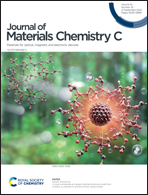Conjugated branch modulated optical characteristics of multibranched push–pull molecules composed of quinoxaline and triphenylamine groups: transition of the conjugated branch from unusual effects to usual effects†
Abstract
In order to improve the optoelectronic performance of π-conjugated molecules with electronic donors and electronic acceptors, people often choose multi-branch molecule structures, which can enhance the charge transfer ability. In this work, the photo-physical characteristics of (E)-4-(2-(3-methylquinoxalin-2-yl)vinyl)-N,N-diphenylaniline (QTPA1) and 4,4′-((1E,1′E)-quinoxaline-2,3-diylbis(ethene-2,1-diyl))bis(N,N-diphenylaniline) (QTPA2) in monodisperse systems and aggregated states were investigated in detail, showing that the photoluminescence quantum yield (PLQY) of oligomers is apparently enhanced in high-polarity solutions and decreased in low-polarity solvents instead, after the oligomer is linked with a conjugated branch. Based on the pump–probe and pump–dump–probe, this unusual phenomenon is assigned to the polarity-dependent intramolecular charge transfer (CT) mechanism of oligomers induced by the conjugated branch. In the PL of aggregated state and the two-photon fluorescence (TPF), increasing the conjugated branch has a positive effect on the PL characteristics that the PL performance of QTPA2 is higher than that of the aggregated QTPA1. In the aggregated state, QTPA2 has a larger degree of π electron conjugation, which suppresses intramolecular vibrations and reduces the energy loss caused by non-radiative processes. In addition, the two-photon absorption section of QTPA2 keeps higher in comparison with that of QTPA1 owing to the enhancement of the intramolecular dipole intensity, leading to the enhancement of TPF. This research could elucidate the physical mechanism underlying the optoelectronic performance and help us develop novel organic optoelectronic materials with high performance.



 Please wait while we load your content...
Please wait while we load your content...